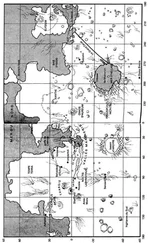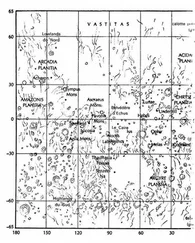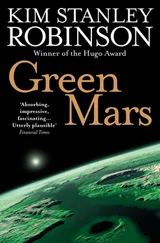Ann looked back and saw it, and was still. They watched the low banded clouds float overhead.
Finally a dinner call from the rovers brought them back. And walking down over the contoured terraces of sand, Nadia knew that she had changed— that, or else the planet was getting much more strange and beautiful as they traveled north. Or both.
• • •
They rolled over flat terraces of yellow sand, sand so fine and hard and clear of rocks that they could go at full speed, slowing down only to shift up or down from one bench to another. Occasionally the rounded slope between terraces gave them some trouble, and once or twice they even had to backtrack to find a way. But usually a route north could be found without difficulty.
On their fourth day in the laminate terrain, the plateau walls flanking their flat wash curved together, and they drove up the cleavage onto a higher plane; and there before them on the new horizon was a white hill, a great rounded thing, like a white Ayers Rock. A white hill— it was ice! A hill of ice, a hundred meters high and a kilometer wide— and when they drove around it, they saw that it continued over the horizon to the north. It was the tip of a glacier, perhaps a tongue of the polar cap itself. In the other cars they were shouting, and in the noise and confusion Nadia could only hear Phyllis, crying “Water! Water!”
Water indeed. Though they had known it was going to be there, it was still startling in the extreme to run into a whole great white hill of it, in fact the tallest hill they had seen in the entire 5,000 kilometers of their voyage. It took them all that first day to get used to it: they stopped the rovers, pointed, chattered, got out to have a look, took surface samples and borings, touched it, climbed up it a ways. Like the sand around it, the ice hill was horizontally laminated, with lines of dust about a centimeter apart. Between the lines the ice was pocked and granular; in this atmospheric pressure it sublimed at almost all temperatures, leaving pitted, rotten side walls to a depth of a few centimeters; under that it was solid, and hard.
“This is a lot of water,” they all said at one point or another. Water, on the surface of Mars….
The next day the glacier hill formed their right horizon, a wall that ran on beside them for the whole day’s drive. Then it really began to seem like a lot of water, especially as over the course of the day the wall got taller, rising to a height of about 300 meters. A kind of white mountain ridge, in fact, walling off their flat-bottomed valley on its east side. And then, over the horizon to the northwest, there appeared another white hill, the top of another ridge poking over the horizon, the base remaining beneath it. Another glacier hill, walling them in to the west, some thirty kilometers away.
So they were in Chasma Borealis, a wind-carved valley that cut north into the ice cap for some 500 kilometers, more than half the distance to the Pole. The chasm’s floor was flat sand, hard as concrete, and often crunchy with a layer of CO2 frost. The chasm’s ice walls were tall, but not vertical; they lay back at an angle less than forty-five degrees, and like the hillsides in the laminate terrain, they were terraced, the terraces ragged with wind erosion and sublimation, the two forces that over tens of thousands of years had cut the whole length of the chasm.
Rather than driving up to the head of the valley, the explorers crossed to the western wall, aiming toward a transponder that had been included in a drop of ice-mining equipment. The sand dunes mid-chasm were low and regular, and the rovers rolled over the corrugated land, up and down, up and down. Then as they crested a sand wave they spotted the drop, no more than two kilometers from the foot of the northwest ice wall: bulky lime-green containers on skeletal landing modules, a strange sight in this world of whites and tans and pinks. “What an eyesore!” Ann exclaimed, but Phyllis and George were cheering.
During the long afternoon, the shadowed western ice side took on a variety of pale colors: the purest water ice was clear and bluish, but most of the hillside was a translucent ivory, copiously tinted by pink and yellow dust. Irregular patches of CO2 ice were a bright pure white; the contrast between dry ice and water ice was vivid, and made it impossible to read the actual contours of the hillside. And foreshortening made it hard to tell how tall the hill really was; it seemed to go up forever, and was probably somewhere between three and five hundred meters above the floor of Borealis.
“This is a lot of water,” Nadia exclaimed.
“And there’s more underground,” Phyllis said. “Our borings show that the cap actually extends many degrees of latitude farther south than we see, buried under the layered terrain.”
“So we have more water than we’ll ever need!”
Ann pursed her mouth unhappily.
• • •
The drop of the mining equipment had determined the site of the ice mining camp: the west wall of Chasma Borealis, at longitude 41°, latitude 83° N. Deimos had just recently followed Phobos under the horizon; they wouldn’t see it again until they returned south of 82° N. The summer nights consisted of an hour’s purple twilight; the rest of the time the sun wheeled around, never more than twenty degrees above the horizon. The six of them spent long hours outside, moving the ice miner to the wall and then setting it up. The main component was a robotic tunnel borer, about the size of one of their rovers. The borer cut into the ice, and passed back cylindrical drums one-and-a-half meters in diameter. When they turned the borer on it made a loud, low buzz, which was louder still if they put their helmets to the ice, or even touched it with their hands. After a while white ice drums thumped into a hopper, and then a small robot forklift carried them to a distillery, which would melt the ice and separate out its considerable load of dust, then refreeze the water into one-meter cubes more suitable for packing in the holds of the rovers. Robot freight rovers would then be perfectly capable of driving to the site, loading up and returning to base on their own, and base would then have a regular water supply, larger than they could ever use. Around four or five million cubic kilometers in the visible polar cap, Edvard calculated, though there were a lot of guesses in the calculation.
They spent several days testing the miner, and deploying an array of solar panels to power it. In the long evenings after dinner Ann would climb the ice wall, ostensibly to take more borings, although Nadia knew she just wanted away from Phyllis and Edvard and George. And naturally she wanted to climb all the way to the top, to get on the polar cap and look around, and take borings of the most recent layers of ice. So one day when the miner had passed all the test routines, she and Nadia and Simon got up at dawn— just after two a.m. — and went out into the supercold morning air and climbed, their shadows like big spiders climbing before them. The slope of the ice was about thirty degrees, steepening and then letting off time after time as they ascended the rough benches in the hill’s layered side.
It was seven a.m. when the slope lay back and they walked onto the surface of the polar cap. To the north was a plain of ice that extended as far as they could see, to a high horizon some thirty kilometers away. Looking back to the south they could see a great distance over the geometric swirls of the layered terrain; it was the longest view Nadia had ever had on Mars.
The ice of the plateau was layered much like the laminated sand below them, with wide bands of dirty pink contouring across cleaner stuff. The other wall of Chasma Borealis lay off to the east, looking almost vertical from their point of view, long, tall, massive: “So much water !” Nadia said again. “It’s more than we’ll ever need.”
Читать дальше
Конец ознакомительного отрывка
Купить книгу












